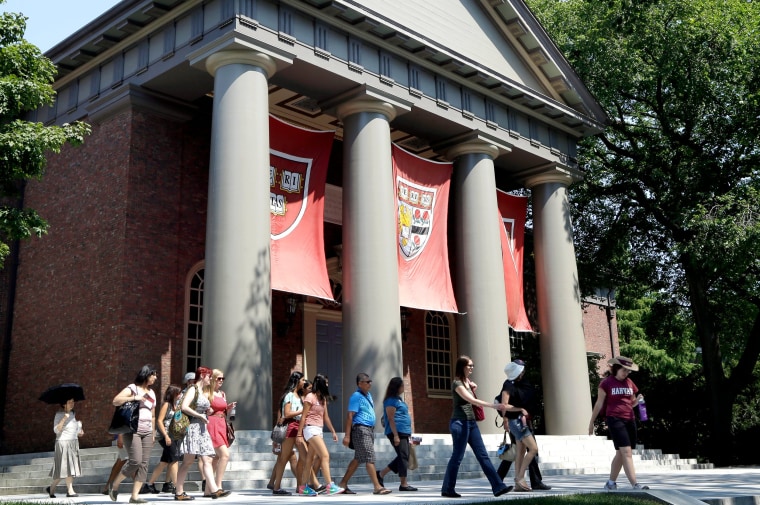As freshmen flood college campuses across the U.S. this year, Harvard University has trumpeted the fact that its incoming first-year class of 2021 is majority non-white. But it left something out.
In recent years, about as many Harvard students have come from the top 1 percent of families by income as the bottom 60 percent, according to a 2017 study. More have come from the top 10 percent by income than the rest of the population. Multi-racial aristocracy is better than all-white aristocracy — but it is still aristocracy.
Part of the problem is that Harvard gives admissions preference based on lineage — providing a significant boost based not on merit but whether or not one’s relatives are a member of the Harvard club.
In fact, a recent Harvard Crimson survey of the 2021 class found that an astounding 29 percent of students — nearly a third — had a relation (parent, grandparent, sibling, aunt, uncle etc.) who attended Harvard. This is almost double the proportion in the survey (16.3 percent) who said their parents lack a four-year college degree.
To put this in context, many more Harvard students have a Harvard relative than are first-generation college students, even though there are 382 times as many American adults age 25 and older without a college degree (143 million) as there are adults in the world with a Harvard degree (375,000).
And it’s not just Harvard. A 2010 study of the top 100 national universities, as ranked by U.S. News & World Report, found that about three quarters provide a preference based on who your daddy or mommy is.
Elite universities offer several excuses for legacy preferences. None ultimately hold up.
1. Just a tiebreaker
Elite colleges claim legacy preferences only come into play for close calls, by providing a feather on the scale. But research from Princeton University's Thomas Espenshade shows that legacy status provides a boost equal to scoring 160 points higher on the SAT (on a scale of 400-1600). Similarly, former Princeton University President William Bowen and colleagues wrote that, within a given SAT-score range, being a legacy increased chances of admission to a selective institution by 20 percentage points.
In 2011, Harvard University researcher Michael Hurwitz found that legacy preferences mattered even more. Looking at fall 2007 applicants to 30 elite schools, his analysis, concluded that legacy preferences of all kinds increased chances of admissions by 23 percentage points. More important, “primary legacy” candidates (sons and daughters, as opposed to siblings, nephews, nieces or grandchildren) saw a whopping 45 percentage point increase in the chances of admission.
2. Legacy preferences are needed to raise money
Many supporters of legacy preferences say they are a necessary evil to keep alumni happy and giving to their alma matter. Surprisingly, institutions of higher education, which are committed to researching virtually every aspect of human endeavor, have conducted little research to test this hypothesis. In 2010, I edited a volume on legacy preferences that included, in my opinion, one of the few rigorous research studies looking into the link between favoring alumni offspring and boosting giving.
Chad Coffman, of Winnemac Consulting, and his co-authors examined alumni giving from 1998 to 2007 at the top 100 national universities (as ranked by U.S. News & World Report). Controlling for the wealth of alumni, they found "no evidence” that legacy-preference policies influence donations. After controls, alumni of legacy-granting institutions gave only $15.39 more per year, on average.
Elite universities offer several excuses for legacy preferences. None ultimately hold up.
Yet even that slight advantage was uncertain from a statistical perspective. Coffman and his colleagues concluded: "There is no statistically significant evidence of a causal relationship between legacy-preference policies and total alumni giving at top universities."
The researchers also examined giving at seven institutions that dropped legacy preferences during the period of the study. They found "no short-term measurable reduction in alumni giving.” For example, after Texas A&M eliminated the use of legacy preferences, in 2004, donations took a small hit, but then increased substantially from 2005 to 2007.
3. Everyone does it
Universities also suggest that legacy preferences are just a fact of life — an inescapable aspect of 21st century higher education. But as journalist Daniel Golden has noted, legacy preferences are "an almost exclusively American custom." Oxford and Cambridge, for example, abolished legacy preferences long ago — as have such leading American universities as the California Institute of Technology, University of California, Berkeley and University of California, Los Angeles.
Ultimately, this is a matter of basic fairness. As the Brookings Institution’s Richard Reeves notes in his smart new book, “Dream Hoarders,” upper-middle class Americans are constantly giving their kids advantages, like reading to them at night or purchasing houses in neighborhoods with strong schools. But legacy preferences cross the line. “This isn’t dad helping us by playing catch in the backyard,” Reeves writes, “This is dad bribing the coach.”
I believe that President Donald Trump may be wrong about many things, but he is right that aspects of the American system are rigged against working-class people. It’s harder to find a purer example of that than providing an advantage in college admissions to students who are already advantaged.
Richard D. Kahlenberg, a senior fellow at The Century Foundation, is the author of six books and editor of 10, including “Affirmative Action for the Rich: Legacy Preferences in College Admissions.”
